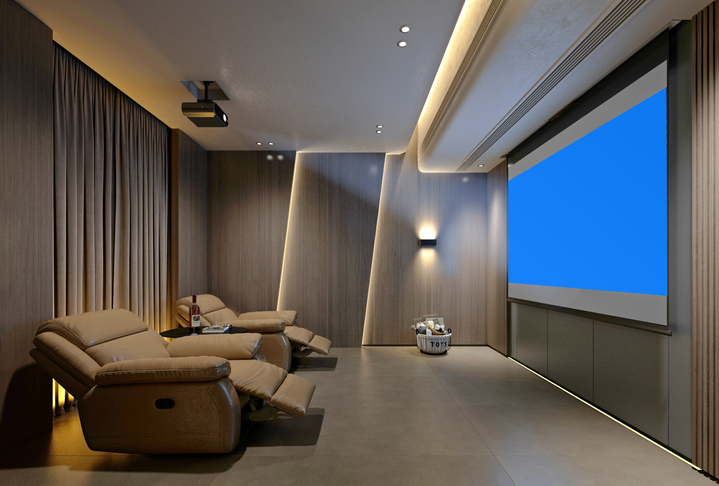Home Theater 101: Every Little Thing You Need to Know for a Cinematic Experience in your home
Producing a home theater that equals the motion picture experience of an industrial theatre entails careful factor to consider of numerous components, including screen option, sound systems, and area format. Whether you are considering the perfect screen dimension or the ins and outs of border sound, comprehending these basics is vital.
Selecting the Right Screen
When setting up a home theater, selecting the appropriate display can make or break the seeing experience - home theater installation tampa. The display acts as the centerpiece of your arrangement, influencing picture high quality, seeing angles, and overall visual. Trick variables to think about include screen kind, resolution, and size
First, establish the ideal display dimension based on your room measurements and seating range. Next, select in between numerous display kinds, such as fixed-frame, motorized, or retractable displays, each offering distinct advantages.
Resolution is an additional crucial aspect. For a really immersive experience, take into consideration a display designed for 4K or perhaps 8K content, making certain sharpness and clarity. In addition, think about the display's gain, which influences illumination and contrast; a higher gain can improve illumination in well-lit areas, while a reduced gain may be better for darker settings.
Choosing Audio Equipment
Audio devices is a critical component of any home movie theater system, dramatically improving the general viewing experience. The option of audio gear can determine the depth, quality, and immersion of sound, important for developing a motion picture ambience.
When choosing audio equipment, consider a border stereo, which usually includes a receiver, multiple speakers, and a subwoofer. A 5.1 or 7.1 channel system is recommended, where the first number stands for the audio speakers and the second the speaker, giving an immersive soundscape. The receiver is the heart of the system, handling audio and video clip signals, and ought to support modern styles like Dolby Atmos for a boosted spatial experience.
Quality audio speakers are necessary; look for designs that use a balanced sound account with great bass action. Floor-standing speakers can produce richer audio, while bookshelf choices save room. Furthermore, consider cordless alternatives for convenience of setup, although wired systems usually provide exceptional efficiency.

Ideal Seating Arrangements
Creating an optimal home theater experience hinges dramatically on ideal seating setups. The arrangement of seats plays an important role in both convenience and viewing quality, straight influencing the total cinematic experience.
First, consider the display size and viewing range. An usual standard is to position seats at a range around 1.5 to 2.5 times the diagonal size of the display. This makes certain an immersive experience without stressing the eyes.
Next, elevation is critical. If your seats remains in a tiered style, the back rows should be more than the front to avoid obstructions. For level seating, make click here now certain that the front row is not also near to the screen, which everyone has a clear line of vision.
Additionally, consider the setup in terms of social characteristics. Team seating can improve the communal experience, while specific seats might be preferred for individual watching.

Last my latest blog post but not least, prioritize convenience with ergonomic seats that supports extended watching periods. Integrating reclining chairs or supported seats can significantly improve the experience, making the home theater a favored location for both entertainment and leisure.
Lighting and Atmosphere
Reliable lighting and ambiance are necessary components of a properly designed home cinema, as they considerably affect the watching experience. The ideal lights can boost the cinematic feel, while inadequate choices can interfere with it. For ideal outcomes, consider a layered lights strategy that includes ambient, task, and accent lighting.
Ambient lighting supplies basic illumination, making sure that the space is not totally dark, which can stress the eyes. Dimmer buttons are highly recommended, permitting adjustments based upon the material being watched. Job lighting, such as wall surface sconces or flooring lamps, uses practical lighting for tasks like analysis or browsing the room without interfering with the total ambience.
Accent lights can be made use of to highlight building functions or create prime focus, adding deepness and passion to the area. LED strip lights behind screens or along shelves can offer a subtle glow that enhances the aesthetic experience without frustrating the audience.

Wiring and Installation Tips
A well-planned wiring setup is vital for achieving optimal efficiency in your house cinema system. Appropriate electrical wiring not only makes certain high-quality sound and video signals however also enhances the total visual of your area. Begin by mapping out your format, recognizing where each element will be put, including your screen, audio speakers, and receiver.
When choosing cords, prioritize high-grade, suitably evaluated circuitry to decrease signal loss. HDMI cable televisions ought to be made use of for video connections, while audio speaker wire ought to match the specifications of your speakers and amplifier. Opt for in-wall ranked cords to follow security standards and maintain a tidy look.

Final Thought
In summary, developing an outstanding home movie theater experience needs careful consideration of various elements, including screen option, audio devices, seating plans, lighting, and wiring. By focusing on these aspects, a motion picture environment can be efficiently reproduced, enabling for immersive seeing experiences that equal typical movie theater settings.
Creating a home movie theater that equals the cinematic experience of a commercial theater entails mindful consideration of numerous parts, consisting of display choice, sound systems, and area layout.When setting up a home cinema, picking the ideal display can make or damage the viewing experience. Next off, select between numerous display types, such as fixed-frame, mechanized, or retracting displays, each offering distinct advantages. For a truly immersive experience, think about a screen created for 4K or also 8K material, guaranteeing intensity and clarity.In summary, developing an exceptional home cinema experience requires mindful consideration of various elements, including screen option, audio devices, seating arrangements, lighting, and circuitry.